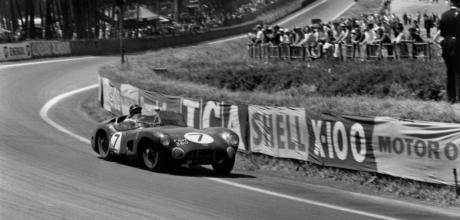Aston Martin drivers Tony Brooks
Not a household name today, but Tony Brooks remains one of Aston Martin’s most accomplished drivers.
Name a British racing driver from the Fifties and the chances are you’ll answer Sir Stirling Moss. But there was another driver from the same period who was just as talented and who many consider to be the best of them all.
Born in Cheshire on 25 February 1932, Charles Anthony Brooks was the son of a dental surgeon and studied the practice himself at Manchester University Dental School. His real passion, though, was motor racing and in 1952 with the support from his father he started competing at club-level, driving the family’s Healey at Silverstone. His best finish being fifth in a five-lap race at Goodwood.
For the following year he swapped over to a faster Frazer Nash owned by a family friend and because he made a good impression over the next two seasons, was invited to drive the factory-entered Frazer Nash Sebring in the 1954 RAC Tourist Trophy at Dundrod, in Co Antrim.
Although Brooks didn’t finish, his potential was evident and only a few weeks later he was asked by Aston Martin’s team manager, John Wyer, to take part in a series of tests at an Oxfordshire airfield, leading the young driver to join the British team from 1955. Brooks made his Aston Martin debut at that year’s Le Mans 24 Hours race, co-driving with John Riseley-Prichard, an insurance broker. While following the Mercedes of Pierre Levegh that crashed into the crowd killing 81 spectators and the driver, Brooks had to brake hard before finding his way through the carnage. He retired after nine hours due to battery failure. Although he’d entered Formula One with BRM in 1956, Brooks stayed with Aston in sports car racing for the next three seasons.
Not always the most successful of partnerships due to the unreliability of the cars, one of Brooks’ greatest successes for the Feltham-based outfit was to win the 1957 Nürburgring 1,000km with Noel Cunningham-Reid in a DBR1. “The race attracted strong entries from both Ferrari and Maserati,” said Cunningham-Reid for Anthony Pritchard’s 2006 book, Aston Martin A Racing History, “but Tony staggered everyone, not just with his speed but the relaxed, comfortable way in which he lapped so fast.”
At Le Mans the same year, Brooks suffered from a terrible accident when the gearbox of his Aston became stuck in fourth and the car overturned onto a sandbank after he entered Tertre Rouge too quickly. “I was lucky in the Le Mans shunt in that I didn’t break anything,” he said years later, “but I did have very severe abrasions – there was a hole in the side of my thigh I could literally have put my fist into.”
Yet just three weeks later he was back in a Vanwall for the British Grand Prix at Aintree. Still suffering from his injuries, the fatigued Brooks handed teammate (Sir) Stirling Moss his car after his had retired. Moss would take the victory (which was jointly awarded to them both), the first time a Britishbuilt car had won a Formula One World Championship race.
Following Moss’s move to Aston Martin in 1957, the pair were teammates in sports car racing and together they won the 1958 RAC Tourist trophy at Goodwood in a DBR1/300 (pictured here with Brooks behind the wheel closely followed by Duncan Hamilton’s Jaguar D-type).
Signing for Ferrari in 1959 when he came close to winning the F1 Championship saw the end of Brooks’ association with Aston, but it was a short-lived transfer and he left the Italian team at the end of the season.
Although he continued in F1 – first with the Yeoman Credit Cooper team and then BRM – by now acutely aware of the sport’s dangers, he lost interest and retired at the end of the 1961 season into relative obscurity.
A man of quiet dignity, despite his six victories in the Formula One World Championship, Brooks never achieved the recognition of his more famous teammate, Sir Stirling Moss, passing away on 3 May 2022, with little acknowledgement or fanfare.
As Moss once said of his friend and former Aston Martin teammate, “Brooks was a tremendous driver, the greatest – if he’ll forgive me saying this – ‘unknown’ racing driver there’s ever been.”


